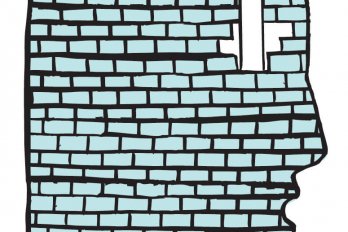kigali—“Right” and “left” are important considerations for any developing nation, but it is motorists, as much as politicians, who have trouble navigating these polarities in Rwanda. I noticed this dramatic tension shortly after arriving at the Kigali International Airport last June. Having driven in some challenging global hot spots—rush hour in Rome, the narrows of Tokyo, the cane-lined roads of rural Barbados—my brake foot has its own passport: it tunes in to the to and fro of traffic as soon as I reach for the safety belt, whether I’m driving or not.
My first inkling that there was something sinister about Rwanda’s vehicular culture came as the driver climbed in behind the steering wheel on the right-hand side of my group’s twelve-passenger jitney. The underpowered minibus, which had no business carrying more than six passengers, let alone twelve, exited the airport roundabout and merged onto the wrong side of the road—that is, the right side.
People tend to travel on the right side for reasons that are far older than cars. Because humans are mostly right-handed, our ancestors hewed at first to the left side of paths, the better to attack or defend with the weapon arm. The switch to the right entrenched itself in the Western world in post-revolutionary France, when aristos, who had once travelled on the left, fell in line with peasants, previously forced to the right. Napoleon’s conquests spread this practice throughout the continent, with the notable exception of Britain, then European imperialism globalized the schism. Until the 1920s, Canada was divided by province, with BC, New Brunswick, Nova Scotia, and pei driving in the British style.
Driving with a wrong-sided steering wheel is common enough—British motorists visiting the continent and vice versa—but Rwanda’s situation is extreme. Like its former colonial master, Belgium, Rwanda drives on the right. But unlike Belgium, where steering wheels are on the left, roughly 80 percent of Rwanda’s steering wheels are on the right. On my way back to Kigali from a tour of Volcano National Park in the northwest, the lunacy of this right-on-right approach became apparent.
Rwanda is a surpassingly beautiful country for driving. The roads are mostly good and the views are stupendous: tea plantation follows banana plantation follows ludicrously lush gorge. Volcanoes loom behind a scrim of mist. Watching the road can be an afterthought, even for a passenger facing oncoming traffic in what ought to be the driver’s seat, but is not.
An hour into the journey, our driver found himself stuck behind an eighteen-wheeler struggling to climb a steep and bending grade. Tucked in along the shoulder, he couldn’t see what was coming, but when he initiated a pass I very suddenly could: a white jitney two-wheeling it around a curve. My brake foot slammed down on a non-existent pedal, and an “Oi, oi!” escaped my larynx. It was enough to stay the steering hand of the driver. The jitney high-beamed its annoyance and our Land Cruiser, chastened, resumed its sluggish pace behind the truck.
“You have to be very careful if you want to overtake a big lorry,” agrees Jean Pierre Sagahutu, a full-time driver who coordinates transport for film productions such as hbo’s Sometimes in April and the Canadian A Sunday in Kigali. Once, Sagahutu tells me, while ferrying a French documentary filmmaker south to Butare, he passed a large truck in typical Rwandan style. This so traumatized his passenger that the Parisian demanded Sagahutu leave him in a small village and return to Kigali to retrieve a different car. Recalls Sagahutu, with a measure of impatience: “He said he didn’t want to die.” (As a Rwandan, Sagahutu can be excused for having a different take on mortal peril.)
The prevalence of Rwandan vehicles with right-side steering wheels dates back to the 1994 genocide, when rampant looting left Rwanda with few roadworthy cars. After the Rwandese Patriotic Front established a government the following year, thousands of exiles—some of whom had been outside the country for more than thirty years—returned home, bringing with them the cars they’d acquired in Uganda, which, as a former British colony, drives on the left-hand side.
To further fill the vehicular vacuum, dealers looked to the thriving used-automobile markets of the United Arab Emirates (uae). Those markets dealt almost exclusively in reconditioned cars from Japan (which drives on the left, thanks largely to the British engineers who helped build Japan’s train system in the nineteenth century). Cars purchased in the uae were then shipped to Rwanda via the port city of Mombasa in Kenya.
That was the standard route until May 2005, when the Rwandan government banned the importation of vehicles with steering wheels on the right, with the aim of eliminating them by 2009. Should that come to pass, Rwandan car owners will have to either hope that uae dealers boost their stocks of cars with steering wheels on the left or pay upward of $1,200—more than five times Rwanda’s per-capita income—to have their steering systems reoriented.
The simplest solution, of course, would be to change the side of the road that people drive on. Canada did, after all. But Sagahutu doesn’t think that will happen here. “People in Rwanda are used to cars driving on the right side of the road,” he says. “Besides, all the government vehicles are left-hand drive.”



